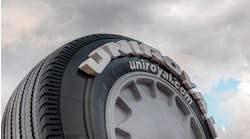Dandelions. Orange oil. Soybean oil. Guayule. With each new experiment in the building process, it’s clear tire makers are in the hunt for sustainable substitutes for rubber compounding materials in the tire manufacturing process.
Similarly “green” is the trend toward reducing low rolling resistance in tires. Although they are still a niche in the market, some see a path toward wider acceptance. Rick Phillips, vice president of sales for Triangle Tire USA, says, “The potential is the entire market. The obstacles are trying to maintain your green initiatives and still be competitive. This is something we are committed to doing and are largely successful, utilizing technology to remain green and competitive at the same time.”
David Shelton, director of industry relations and communications for Giti Tire (USA) Ltd., sees that potential. He thinks consumers will want more fuel efficient tires, “but at what price? Giti is searching for ways to reduce rolling resistance, without losing performance in grip, durability, life, comfort or quiet — and without requiring a price beyond the consumer’s comfort zone.”
Shelton says there could be another market driver entirely. “Original equipment manufacturers are seeking low rolling resistance to help meet the latest fuel efficiency rating requirements. This may drive a broad effort to develop more fuel efficient tires for most passenger and light truck categories, instead of a specific ‘eco tire’ category.”
Richard Li, marketing director for Zhongce Rubber Group Co. Ltd. (ZC Rubber), doesn’t see such a clear path ahead. He thinks consumers will continue to ask for tires that are safe and a good value, and that will keep tire manufacturers focused on tire performance. “The green tire will be treated as a secondary priority compared to tire quality and performance.”
Green performance is ‘true technology’
For some companies, green tires are a part of a larger green, environmentally friendly mission. “Bridgestone remains committed to manufacturing all of our products from fully sustainable materials by 2050,” says Bill Niaura, director of collaborations and open innovation at Bridgestone Americas Inc. “This has and will continue to occur in incremental steps as materials become available to the marketplace or technologies are developed internally.”
Hyoung Nam Kim, chief of global research and development for Hankook Tire Co. Ltd., says finished products should have low rolling resistance and strong resistance to abrasion. The real key is putting it all together.
“To lower rolling resistance, materials such as high performance polymer or silica should be developed and used. Light and high-intensity materials are used to reduce tire weight and enhance fuel efficiency.
“Maintaining high performance in eco-friendly tires is true technology.”
For Kenda USA, the materials and process are important, but Brandon Stotsenburg, vice president of automotive, says the company also is working on solutions to age-old tire issues, like how to improve air retention in tires, which helps maintain low rolling resistance.
“Our technical center in North Canton (Ohio) has a room specially dedicated to measure air retention. It allows us to isolate the elements so we can closely look at permeation through the sidewalls and continue to make enhancements accordingly.”
What about the steel?
When it comes to sustainable production and materials, the focus is nearly always on the rubber. But what about the steel used in tire production? In light of the talk of higher tariffs on imported steel, it seems logical to focus on steel, too.
“The search for a replacement for steel has been an effort for decades,” says Giti’s Shelton. “Alternatives may exist; however, the costs are not tenable. When the price and performance and durability capabilities balance, a transition can begin.”
Niaura at Bridgestone says steel will continue to be a reinforcing material in tires for the near term.
“The good news is that steel is one of the most recycled materials in our economy. It can be considered semi-sustainable because of its re-use.
“Longer term, we continue to evaluate alternate reinforcing materials and, considering the rapidly changing mobility landscape, some passenger tires may be non-pneumatic in the foreseeable future. Non-pneumatic tires may be entirely different in terms of materials and reinforcing technologies.” ■
Tips for selling more green tires
Modern Tire Dealer asked tire makers for ideas on how to sell more green tires. Here’s the advice from the experts at Kenda USA, Triangle Tire USA and Giti Tire (USA) Ltd.
Brandon Stotsenburg, vice president of automotive for Kenda, suggests dealers dedicate a point-of-sale location to eco-friendly tires. It could feature images and displays that highlight the benefits of improved fuel economy and rolling resistance.
“It entices the consumer to at least ask a question about green tires and initiate a conversation. At the very least, it raises awareness of green tire technology within our industry.” Some consumers will be drawn to it naturally, such as those who own smart cars or hybrids, Stotsenburg says. “When a customer who owns one of those vehicles enters the store, encourage salespeople to mention the benefits of the green tires, as they’re more likely to purchase.”
David Shelton, director of industry relations and communications for Giti, agrees there are some natural customers for green tires. “Surveys say there is a growing group of consumers who are willing to pay more for products which are produced more responsibly, or are more easily recycled. If the reduction in rolling resistance provides sufficient financial fuel cost saving to the consumer, then it is an easy sale. As fuel prices increase, this opportunity increases.”
Rick Phillips of Triangle says there’s an opportunity to talk about technology in the tires, and how it could leave consumers with more green in their pocket.
“Green products run cooler and they will result in less fuel consumption for the consumer due to lower rolling resistance. So they not only provide a benefit to the environment but they result in a direct savings for the consumer by spending less money on gas.”



